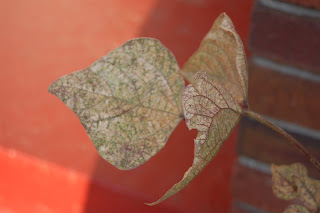The kale has been growing well for months now and we have been picking as needed. A few week ago I thought I noticed some white-fly larvae on the underside of some of the leaves, but I never made the time to spray with Neem oil. As expected, the infestation got worse and a few days ago I brushed up against the Kale and some of the white-flies fluttered around. It still was not nearly as bad as it was last year though. This is mainly because last year I had no idea what they were, or anything about them. I searched for a bit online, but it was only until I looked in some old gardening books that I was able to figure it out.
Now that I know them, they are so easy to identify. They are tiny little white bugs that almost look like dust when you brush against the leaves of kale. They look much more like tiny little white moths, rather than house flies. They are similar to aphids in that they suck on the leaves and excrete a sticky residue on the underside of the leaves. Left untouched for a while, they will eventually kill the leaves.
The thing that bothers me the most is that they leave little things on the back of the leaves that are hard to wash off. I think it is the adhesive left over after the eggs hatch, but I really have no idea.
Interestingly, there are no signs of white-flies on the collards or anything else.
Anyway, rather than try to fight the already existing infestation with Neem Oil like I did last year, I decided to harvest the entire crop, sparing only stems and the newest leaves. I have read that as long as the heart is in tact, new leaves will still come. I have no idea if it will work, but it's worth a try. Once all of the leaves were harvested, I did spray Neem on what was left. I'm going to re-apply once a week and just see what happens
At first I was going to blanch and freeze some of the kale and keep the rest in the fridge. After blanching the first batch and seeing well it removed all of the stuff that was stuck to the leaves, I decided to just freeze the whole batch. Here are some pics from the process:
 |
| Sorting |
 |
| Washing |
 |
| Packaging |

























